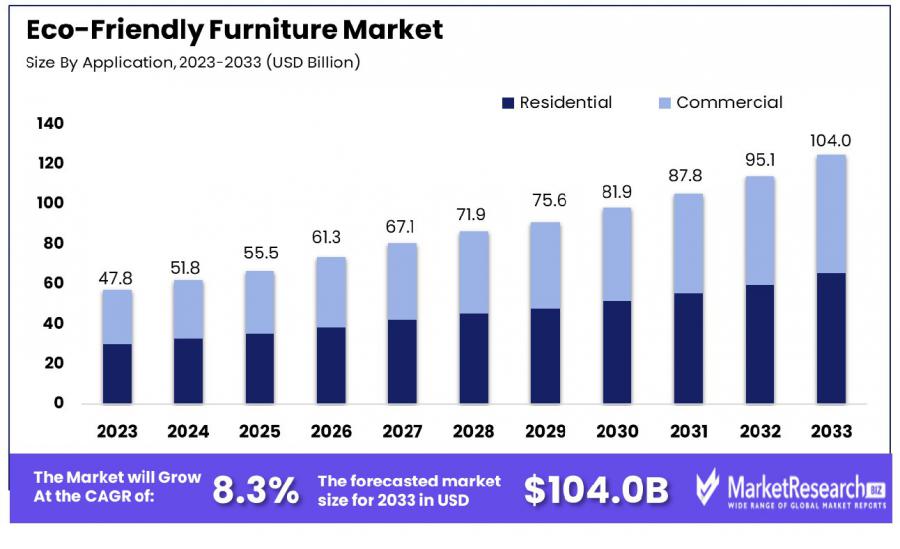
Eco-Friendly Furniture Market Set to Reach USD 104.0 Billion by 2033, Growing at a CAGR of 8.3%
The eco-friendly furniture market, valued at USD 47.8B in 2023, is projected to reach USD 104B by 2033, growing at a CAGR of 8.3%.
NEW YORK, NY, UNITED STATES, January 22, 2025 /EINPresswire.com/ -- Report Overview
The Global Eco-Friendly Furniture Market was valued at USD 47.8 billion in 2023 and is projected to grow to USD 104.0 billion by 2033, registering a compound annual growth rate (CAGR) of 8.3% from 2024 to 2033.
Eco-friendly furniture refers to furnishings made from sustainable, non-toxic materials and produced through environmentally responsible processes. These products often utilize recycled or reclaimed wood, organic fabrics, and low-VOC finishes, aiming to reduce the carbon footprint of traditional furniture manufacturing. This market caters to consumers who seek long-lasting, environmentally conscious alternatives to conventional furniture, ensuring minimal environmental impact throughout the lifecycle of the product, from sourcing to disposal.
The eco-friendly furniture market is growing rapidly, driven by a shift in consumer preferences toward sustainability and health-conscious living. As environmental awareness increases globally, the demand for sustainable furniture is rising, creating significant opportunities for brands that can innovate with eco-friendly materials and manufacturing methods. Companies that align their products with these values are well-positioned to capture a larger market share, particularly as consumers seek products that match their ethical and environmental standards.
Request a Detailed Sample Report and Discover Key Insights at https://marketresearch.biz/report/eco-friendly-furniture-market/request-sample/
Key Takeaways
~~ The eco-friendly furniture market was valued at USD 47.8 billion in 2023 and is projected to reach USD 104.0 billion by 2033, growing at a CAGR of 8.3% from 2024 to 2033.
~~ The residential sector holds a 55.2% market share, driven by strong consumer demand for sustainable furniture options in homes.
~~ Offline channels account for 65.7% of the market share, indicating that traditional retail remains the dominant sales channel for eco-friendly furniture.
~~ North America leads the market with a 44.2% share, reflecting strong consumer interest and demand in the region for sustainable and environmentally friendly products.
Regional Analysis
North America Dominating the Eco-Friendly Furniture Market with 44.2% Market Share
The Eco-Friendly Furniture Market in North America holds a commanding position, contributing 44.2% to the global market in 2023, valued at USD 44.2 billion. This dominance is attributed to increasing consumer awareness regarding sustainability and eco-conscious living, which has propelled the demand for environmentally friendly furniture products.
Additionally, the region's robust retail infrastructure, coupled with supportive government initiatives promoting green initiatives, further accelerates the market's growth. North America's strong environmental regulations and consumer preference for sustainable living options are expected to continue driving the market forward in the coming years. With its established presence and substantial market size, North America remains the key region in the global eco-friendly furniture market.
Europe, Asia Pacific, Latin America, and the Middle East & Africa also represent emerging markets, with varying growth rates, but North America’s share remains significantly higher than other regions, reinforcing its leadership in the market.
Report Segmentation
In 2023, the Eco-Friendly Furniture Market was primarily driven by the Residential sector, which held a dominant 55.2% market share. This growth was fueled by increasing consumer awareness of sustainability and a preference for eco-friendly living spaces, with a rising demand for materials like bamboo, reclaimed wood, and recycled plastics. The Residential sector's growth was further supported by a global increase in residential construction. While the Commercial sector also saw growth due to corporate responsibility initiatives and the adoption of green practices in offices, hospitality, and education, its market share remained smaller. Overall, the market reflects a broader societal shift toward sustainability, with strong potential for continued innovation and expansion in the Residential segment.
In 2023, the Eco-Friendly Furniture Market was primarily dominated by offline distribution channels, which held a 65.7% market share. This dominance is driven by consumer preferences for physically experiencing products, the personalized services offered by brick-and-mortar stores, and trust in established retail brands. While the online channel also saw growth due to e-commerce convenience, improved logistics, and digital tools like VR and AR, it remained secondary to offline sales. The market's landscape suggests a balanced growth trajectory for both channels as digitalization progresses alongside the enduring appeal of physical retail experiences.
Key Market Segments
By Application
~~ Residential
~~ Commercial
By Distribution Channel
~~ Offline
~~ Online
Purchase the Complete Report Now with up to 30% off at https://marketresearch.biz/purchase-report/?report_id=16479
Major Challenges
~ Supply Chain and Sourcing Challenges: While eco-friendly furniture has become popular, sourcing the materials required for these products can present challenges. Producers face issues related to ensuring the materials are sustainably harvested and the production process minimizes environmental impact. Additionally, there is often a higher cost to obtain certified materials, which can lead to increased production costs.
~ Consumer Education and Awareness: Many consumers are still unaware of the environmental and health benefits of eco-friendly furniture. A lack of education regarding eco-certifications and product sustainability can prevent consumers from making informed decisions. Retailers and manufacturers must do more to raise awareness and provide transparency about the sourcing, materials, and benefits of eco-friendly products.
Emerging Trends
~ Sustainable Materials Innovation: Manufacturers are innovating with new materials that offer both functionality and sustainability. For example, biodegradable composites and plant-based fibers are gaining traction for their eco-friendly nature and aesthetic appeal.
~ Rise in Eco-Conscious Consumer Behavior: With growing environmental concerns, more consumers are prioritizing eco-friendly choices when purchasing furniture. This shift is being driven by the desire to reduce personal carbon footprints and support brands that align with sustainability values.
~ Increased Use of Recycled Materials: The incorporation of recycled materials in furniture design is becoming a major trend. Recycled wood, metal, and plastics are being used to create stylish and functional products, reducing the need for raw materials and minimizing waste.
Top Use Cases
~ Home Furniture: Many households are opting for sustainable furniture pieces for their living rooms, bedrooms, and dining areas. Eco-friendly home furniture often features minimalistic designs, durability, and the use of non-toxic paints and finishes.
~ Office Furniture: As businesses increasingly adopt green practices, eco-friendly office furniture is in demand. This includes ergonomic desks, chairs, and storage units made from sustainable materials such as reclaimed wood or biodegradable composites.
~ Outdoor Furniture: With the growth of sustainable outdoor living, eco-friendly outdoor furniture made from recycled plastic or bamboo is becoming popular. These products are designed to withstand the elements while being environmentally friendly.
Top Opportunities:
~ ~ Growth in Urbanization: As more people move to urban areas, the demand for compact and sustainable furniture solutions that fit small living spaces is increasing. Eco-friendly furniture providers can target this growing market with space-efficient, sustainable designs.
~~ Technological Advancements in Materials: Innovations in materials technology, such as the development of new biodegradable and sustainable materials, present significant opportunities for manufacturers to expand their product offerings.
~~Expansion in Emerging Markets: As awareness of sustainability grows globally, emerging markets in Asia, Africa, and Latin America are expected to become key regions for eco-friendly furniture adoption. Companies can capitalize on this by tailoring products to local tastes and preferences while promoting eco-conscious living.
Key Players Analysis
In 2024, key players in the global eco-friendly furniture market are driving growth through sustainable practices. Vermont Woods Studios and Cisco Brothers Corporation emphasize locally sourced, FSC-certified materials and organic fabrics. Brands like Sabai and Greenington focus on bamboo and eco-friendly production methods. Larger companies such as Lee Industries, Williams-Sonoma, and La-Z-Boy are incorporating eco-conscious designs into their mainstream collections. Luxury brands like Roche Bobois and Maiden Home are combining sustainability with high-end aesthetics. Global leaders like IKEA and Ashley Furniture are reducing their carbon footprint and improving recyclability across their products. This diverse mix of strategies reflects a market committed to both environmental responsibility and consumer demand for stylish, functional furniture.
Market Key Players
~ Vermont Woods Studios
~ Cisco Brothers Corporation
~ Sabai
~ Greenington
~ Lee Industries, Inc.
~ Williams-Sonoma, Inc.
~ La-Z-Boy Inc.
~ Vestre
~ KING Furniture Pty Ltd
~ Maiden Home
~ Ashley Furniture Industries, Inc.
~ Ethan Allen Global, Inc.
~ Roche Bobois
~ Inter IKEA Systems B.V.
Conclusion
The global eco-friendly furniture market is poised for significant growth, driven by rising consumer awareness and a growing demand for sustainable living solutions. With a projected market size of USD 104.0 billion by 2033, growing at a CAGR of 8.3%, this sector presents substantial opportunities for innovation and market expansion, particularly in the residential sector. North America leads the market, but emerging regions like Europe and Asia Pacific show promising growth potential. While challenges such as sourcing sustainable materials and educating consumers remain, companies committed to sustainability are well-positioned to capitalize on the shift toward eco-conscious products. As both offline and online channels evolve, the market is expected to continue its positive trajectory, offering new opportunities for both established and emerging brands.
Lawrence John
Prudour
+91 9130855334
email us here
Visit us on social media:
Facebook
LinkedIn
Distribution channels: Furniture & Woodworking Industry
Legal Disclaimer:
EIN Presswire provides this news content "as is" without warranty of any kind. We do not accept any responsibility or liability for the accuracy, content, images, videos, licenses, completeness, legality, or reliability of the information contained in this article. If you have any complaints or copyright issues related to this article, kindly contact the author above.
Submit your press release


